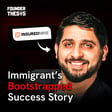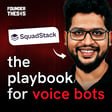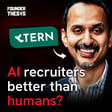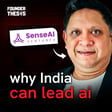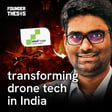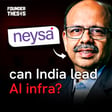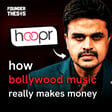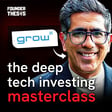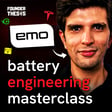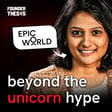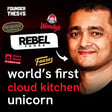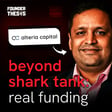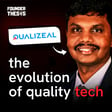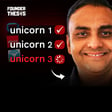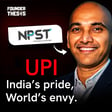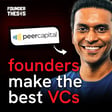Introduction to Shankar Prasad and LumGurus
00:00:00
Speaker
Hi, I am Shankar Prasad. I am founder and CEO of Lum, also known as LumGurus. It's one of India's first new rates new events.
The Rise of D2C Brands in India
00:00:22
Speaker
D2C brands have become the latest buzz after Mama Earth's IPO and this episode is a masterclass in using first principles to build a D2C brand. Shankar Prasad has spent a decade in building Plum, the D2C beauty and personal care brand that my team loves using.
00:00:40
Speaker
Of that decade, the first five years were a pure bootstrap journey which really helped him build a solid foundation of great product quality and a frugal and customer-obsessed culture which today continue to hold strong even after they have raised about $50 million.
Plum's Mission and Ethical Commitments
00:00:55
Speaker
Shankar's humility and first principles thinking are what inspires a more honest and sustainable approach to scaling up.
00:01:11
Speaker
Shankar, could you give me an elevator pitch for Plum? Why does Plum matter? Why should our listeners care about Plum?
00:01:21
Speaker
Right, so this is something I solved for right when I was in the desired phase. And one of the questions that I read in this book called The Art of the Start by Kaiko Kawasaki was why is your world in a better place when your brand is around or why is it a worse place when your brand is not in a question. So I think the answer that we put down then thankfully is still the answer that is even after 10 years the same answer.
00:01:51
Speaker
that we aim to add goodness to this world through our products brand and through our thoughts and actions. Personal care, beauty, cosmetics, this is almost incidental to why we exist. The reason the brand exists is to add goodness to this world and that's why Plum goodness is something that is the second name of this brand.
00:02:15
Speaker
So that's really the elevator pitch. So just add more good to the world. Everybody knows what good is, even less, so just add more good to the world. So, you know, I'm going to play a little bit of the devil's advocate here. I'm sure you've heard of WeWork, right? And when WeWork took out its IPO, it was generally lambasted for having a lot of
00:02:39
Speaker
feel good terms in it without real numbers. And so, you know, add goodness to the world is, yes, feel good, but it's very vague. Yeah. And I'm okay with it being vague. I get challenged on this a lot. So many brands talk about goodness. You know, you're not the first person to talk about it and so on and so forth, but I just believe it's one thing to talk about it and one thing to give it.
00:03:06
Speaker
And I can't talk about living it. Those who experience it understand that we live it. And it's not just the products I'm talking about here. Yeah, give me some examples of how you're living it. So for example, when we began, we were India's first brand to say that we will give one percent of our sales to the environment.
Customer Delight at Plum
00:03:24
Speaker
And at that time, we knew of this movement called One Percent for the Planet. When we began, we said that we will not do a fairness cream. And mind you, this was in 2014.
00:03:34
Speaker
When the market was only final stream, I remember having extended debates with my friends at the time saying you can never enter the skincare industry without having no final stream and we went down to record to say that we will not be making the final stream and you will see where the weather world is now. Customer delight remains our number one value. Again, one can debate that it is motherhood and apple pie, but at the end of the day, if the
00:04:02
Speaker
the doing is the talking, then I dare say that we do a lot more than we talk on that front. In fact, the one-minute break that you gave me before we started this, because I was actually responding to a customer conflict that got escalated. Me, I was responding. And I was making sure that it is being responded to, even though we have a dedicated customer team and so on and so forth. But we make sure that we don't, you know,
00:04:28
Speaker
let things lie unattended or just because you've grown to a certain scale, think that the single customer is beyond that. So I think that ethos sort of permeates through the workplace here.
Plum's Growth and Financial Strategy
00:04:44
Speaker
Give me some numbers about Plum. How much will you do revenue wise by the end of current year, as per your estimation? Beginning to sound like a boat meeting already. But I think, okay, so let me talk in terms of, that's more fashionable for startups to do.
00:05:04
Speaker
We should be at 400 CR. We are already at 400 CR. For the full year at the 400 CR number, we are very close to it as well, if all goes well. I think to me, the potential of this brand is much more than that. And neither have we in a hurry to say, I get to this number based on the date. And sure, we have those targets and we have those board meetings to look at those targets. But for me right now, this journey is about
00:05:34
Speaker
building the brand, taking people along with it. And when I say people, I mean consumers along with it on this journey. And given the kind of market that we operate in, which is India, one and a half billion people, our vision is to touch a billion lives every day. And maybe we'll get there in four years, 10 years, 20 years, we'll get there. Wow, amazing. And what kind of fundraise have you done till date?
00:05:59
Speaker
So we've had three, first of all we bootstrapped for five years. So when we began in 2013, it was till late 2018, which is about five years back, is we were bootstrapped and it was profitable in 2016 itself. We were quite small, but we were probably bootstrapped. And I still bore my team with those worries every day.
00:06:20
Speaker
And we raised our first round of money in 2018, that was from the earlier ventures, very small round. Back then it was headlines, but now in today's day and age, it is probably less than an angel round. And then we raised our series B in the height of COVID, which was late 2020. And the last round came sometime early last year, around April 2022.
00:06:45
Speaker
and that is from A91.
Shankar Prasad's Background and Influences
00:06:47
Speaker
So there's Unilever Ventures series, a fairing capital series, BN, A91 partner, the CDC. And I think more than $50 million in total across these rounds. No, less than that. I think, yeah, I think just less than that. Yeah, you can say approximately that. Approximately $50 million. OK, OK. Tell me about the journey. So you bootstrapped for five years.
00:07:15
Speaker
What was it that led to the birth of Plum? First tell me about that and then tell me about that five-year bootstrapping journey. What were you doing before you decided to start Plum? There's this concept of founder market fit. What was your founder market fit? Why are you the right founder for Plum? Well, I'll go back in time and go back into the last century, almost. That's when I graduated from college.
00:07:44
Speaker
Coming out of IIT Bombay, I was a hardcore chemical engineer as I used to call it. I still love chemical engineering. There's still a book here in my drawer of my favourite subject. So, I was a hardcore chemical engineer and I could have chosen to get into hardcore chemical engineering.
00:08:05
Speaker
I saw the placement brochure of what at that time was Hindustan Lever, which today is now Hindustan Unilever. Hindustan Lever had a very colourful placement brochure. There was one image in that placement brochure that caught my eye. It was a photograph, back then everything was hard copy. I'm talking last year. There was a photograph of an ice cream production line. I think I saw it was something
00:08:35
Speaker
of corridors coming off the line in that photograph. And I said, this looks like a fun place to be. It's got a lot of color. It's got a lot of energy. It's got a lot of engineering as well to produce something like that. And of course, H-E-L used to pay well. I think H-E-L used to pay well then. And it was a day one company. And so I said, this is the place I want to get into to make fun stuff like this. I had no idea what this was all about. It was just liking that I got.
00:09:04
Speaker
But I have to thank anyone who had produced that placement brochure for a dual I have to thank because they had caught me into this industry and thankfully I stopped there for three years. In four years in manufacturing, four years in R&D.
00:09:20
Speaker
That really formed the foundation for a lot of things that I do. I still have a lot of respect for the organization. In fact, I was happy for them in your ventures to be in a series of investors. For me, being at consumer goods has always been very interesting.
00:09:40
Speaker
So, I left at you to do my MBA from ISP. I joined McKinsey. I was there for a couple of years, but in those couple of years, I did one consumer study. I sought it out. I said, I want to do one consumer study. I just don't want to worry about this space. And even when I left McKinsey to join what I call the task of building a business, and I was agnostic to what business I was building, not as an entrepreneur, but as a part of the team.
00:10:05
Speaker
I chose retail financial services again. I just like the consumer side of things a lot, lot, lot more, even when it comes to financial services compared to the wholesale side of things. And as luck would have it, the primary equity fund that I was working for had bought a majority stake in Faces Canada, which is a cosmetic standard. That's where I learned the front end of the business I got to operate that business for.
00:10:31
Speaker
close to five years. You were like the CEO for India's workplaces. For a couple of years, yes. And then the full-time CEO joined but I was still working very closely with him. I completely enjoyed listening. I think without me knowing and I had no intentions of becoming an author cannot be very honest.
00:10:51
Speaker
But without me knowing, I was practicing all those skills and necessary to be an entrepreneur. So it sort of, I started very late as an entrepreneur. I have worked at 38 and I started out. Wow, that's inspiring.
00:11:08
Speaker
Yeah, so to me, my inspiration is Falguni. She started even months later in life. Falguni Nair of Nika, right. Yeah, absolutely. I mean, I mean, I took to be in this industry with no background and then to build something that is as special as Nika. I mean, I have a lot of respect for her and for what she's doing. Yeah, absolutely.
00:11:35
Speaker
I want to zoom in a little bit on what you took me through, the pre-plum journey. In R&D at HUL, what kind of products did you develop? Was it again beauty and like skincare? So, it's tough to believe it when I tell you that I myself find it really tough to believe. But back then, the largest business when I lived in India was soaps and detergents. So, most of the
00:12:06
Speaker
I would say a part of the good guys group, but most of the good guys used to be in soaps and detergents back then, or at least most of the guys used to be in soaps and detergents without necessarily qualifying that. This was when HUL and Nirma were like really in a tough battle for... Yeah, those were the days. Correct. Absolutely. And personal products, as it was called, was beginning to be dominated by the likes of shampoo and stuff like that.
00:12:33
Speaker
India was at toothpaste. So, India was moving from household penetration and now 99%. Shampoo penetration was around 90% or thereabouts and India was just beginning, so the cusp of the beginning of
Launching and Growing Plum
00:12:49
Speaker
this whole personal care revolution in this country, skin care was down to famously. And face swash, we had to convince people that face swash is better than soap. Otherwise, people are using the same bar of soap for their face also. And it sounds like another era, but it's only 20-25 years back. And people had to be convinced why shower dales are better than soap. I mean, we used to have brainstorm sessions on how do you get people to use shower dales in this country.
00:13:17
Speaker
Anyway, the reason I am giving all this context is this is largely what used to happen and I was part of in R&D a team that worked on soap formulations. I still remember most of the technology behind it and the thing about working on soap formulation is you cannot do anything in the lab. You have to do it either in a pilot plant because the soap processing is sort of heavy duty.
00:13:41
Speaker
And more importantly, anything that you do has to be applicable at a very large scale almost immediately. For example, the project that I worked on for Lux, the volume at that time was almost 80,000 tonnes per annum. You push the button on your formulation, it gets replicated to, I think, almost eight factories running two lines each at 400 tablets a minute.
00:14:10
Speaker
and you get something wrong, probably stuff starts hitting the fan very quickly. It's a very different, it used to be a very different game with soaps. Whereas what we do right now in contrast is,
00:14:30
Speaker
100 kilo batch with tender loving care filled into 50 mN tubes, a few thousand pieces or a few tens of thousands of pieces right now. And not that that is necessarily more complex and this is necessarily less complex. But I think the nature of the game is no different
00:14:51
Speaker
What I am finding is many of the principles are still applicable in terms of being able to scale up properly, in terms of doing it first time right, solving for robustness of the formulation, solving for variances in the raw material quality that we get, in solving for people who go to manufacture it. So, I think all that experience even though that was 80,000 tonnes per annum and this is 100 kilo batch, it does not really change much the
00:15:20
Speaker
Interesting. Coming to your private equity experience, what did you learn when you were running Faces Canada? So you essentially were like an entrepreneur, right? You were taking Faces from the zero to one journey in India. Was it the right product for India?
00:15:39
Speaker
It wasn't. So, we thought it was before we went in. What was the product just for people who don't know what is faces? Okay, so again, a little bit of history, it will humor me. Faces was started in the 1970s in Canada. The Fed still got Faces Canada here.
00:15:56
Speaker
and what faces was known for in Canada and Canada is a far more diverse society than let's say the US or the UK for longer and what faces was known for is a range that they had. So, for example, if I remember correctly, they had 120 shades of eyeshadow and 100 shades of lipstick to begin with. So, it was all color cosmetics, lips, eyes, face and nail also.
00:16:23
Speaker
And so, thesis was known for its diversity in the shade range. And therefore, the hypothesis was, and quality of the product. So the hypothesis was, we would be able to bring those products to India. And India was a product-starved country, I'm talking 15 years back, in the world of makeup and color moisturisation. Because you had a bunch of incumbent brands and that's about it. There was no deal at all. We were literally brand number seven entering the market, among the media brands.
00:16:53
Speaker
So, we thought that we will be able to get those products and sell them in India. I still vividly remember a conversation I had with one of the regional managers who had just started off in places. So, none of these shades will work here.
00:17:08
Speaker
We have 100 shades of lipstick and you are saying out of those 100, and I am a guy, I don't understand these nuances. So, I didn't used to at least. And I came from a background of this one. So, we have 100 shades and you are saying not one of those 100 shades. She said, no, 100 shades will work. That's when I realized that this world of makeup and color enforcement is extremely nuanced. Extremely nuanced. It's not as if those 100 is in a range from yellow to purple. They are all reds and pinks and browns.
00:17:36
Speaker
weapons and nudes. Within that, the 100 was not working here. And so, in a long story short, we had to abandon the thought of bringing products from Canada to India. We had to set up local back-end, local manufacturing or localised product development. Where again, I think my experience in the past
00:18:00
Speaker
But to me, what I learned more in Phasers was, of course, beyond these nuances which I learned through Shock Therapy. But I also learned the front end of the business, which I never see the net you. I used to go on market business, but I never really sold.
Challenges of Scaling as a Bootstrap Venture
00:18:16
Speaker
And to be selling a 550 rupee product or a 450 rupee product, these are the 15 rupees or 25 rupees.
00:18:23
Speaker
So, it is very different. To be selling in an assisted environment where there is a sales advisor who needs to be trained, who needs to be motivated, who needs to be coached to explain the product, you know, features better and to manage this entire system of high diversity of product, high inventory and what not.
00:18:48
Speaker
That was the first time I learnt all of that and I think even though I was learning, I dare say I was able to contribute positively only because I brought an extreme amount of what I call in a Hindi term. It is just punk.
00:19:08
Speaker
the whole thing, the diversity died. And I think the team was also new. There were not a lot of people who were experienced in the world of Meeku Khan Khan. The talent pool was still raw, relatively speaking. And so all of us put in the best we had and tried to build whatever we could. And so it was all in, all hands on deck, all guns firing all the time.
00:19:34
Speaker
Would you call it a success in India? I've not really heard of faces as a brand, but I'm a man, so it's quite likely that's why I've not heard of it. It depends on how you design success. So if success is still being in business after 16 years in a dog eat dog competitive market, I think it is a success. If success is having a bunch of, I don't track them anymore because commercial trustee in hands many, many times, but I know that they're very much alive and kicking.
00:20:04
Speaker
And in fact, more than that. If you define success as having a bunch of customers who swear by at least some of your products, it's not many. That's still a success. I don't know if, you know, I really don't know of the scale at which they are at. And keep track, as I said.
00:20:23
Speaker
But, the fact that they are around and the fact that they are very much in the consumer consideration set after all these years in a market which has seen a lot of people come as well, tells me that it is still alive and I am happy to see that as somebody who put the first brakes on the ground.
00:20:40
Speaker
to build something like that. I feel happy every time I see something that was started then is still very much around and doing well. Also, this is a debate I keep having with my team on what do you define as Grad Success more generally.
00:20:59
Speaker
And I keep asking them about brands and say, do you know if brand X or brand Y is bigger? And both are good brands. And they say, I don't even know the scale of these brands. But I said, do you recognize that they are good brands? They said, yes. Typically, they do. Do I pick X or Y in such a way that they are good brands? So many brands. Do we know, for example, if Adidas is bigger than Nike, not from our industry? Do we even care?
00:21:24
Speaker
The fact is both are great brands. The fact is both are having very relevant products to offer. The fact is both are in our consideration set when you go out to buy a brand of sneakers. I think that's what the world of branded goods is about. It's never really about scale alone because the world of branded goods is not about a winner take all.
00:21:45
Speaker
It is not a cab hailing or a food delivery kind of an ecosystem where you have two people and it's electrically one of the two. You typically select from a bunch of 20, 30, 200, 300. There is this multiplicity. So that's the way I think about plants.
00:22:03
Speaker
Okay, interesting. So when you decided to quit private equity and start plum, what kind of corpus did you start with? You must have put in your life savings into it. And how did that corpus help you get off the ground? And how did you hit profitability in two years? So initially, I thought I'll raise money before I get to it.
Frugality and Sustainable Growth
00:22:27
Speaker
Because I came, by default I came from that environment and I found this and that. But then as the day started passing, I found the doing far more interesting than talking to people about giving me money. And I therefore just got into the doing of it. From a money point of view, what I had done was, you know, my provident fund or pension fund, depending on what you call it,
00:22:52
Speaker
I drew it down completely and I broke, I sort of divided mentally into two parts. One part is not to be ducked, another part that needs to be sort of deployed into this business and let's see where that fuel will take us. I began extremely frugal, extremely, extremely frugal. Of course did not take a salary, you know, I can't pay myself.
00:23:18
Speaker
So that round ripping is sort of ridiculous, but I mean for the first three years, more than three years I didn't take a sample even when I started taking it to the victims. So every rupee was funneled or fueled into what I always maintained was building the brand. And therefore we operated out of a two room apartment for close to four years.
00:23:47
Speaker
It's only 2017 that we bought an office that was a very small office, which also I negotiated the rent of my crazy aunt. So, I let go of a lot of places just because there was a 10,000 rupee monthly rental difference between where I wanted to be and where that place was. So, I should be extremely brutal about money.
00:24:09
Speaker
Unfair or unreal, but very tight. That's what I mean by good. And very careful in general. Careful is a better word there. And I had a sort of a least count in my mind. I still have that. It's just that the numbers increased. There is a cost and benefit of worrying about spending something.
00:24:31
Speaker
You worry too much about spending that amount of money, that opportunity cost of deploying that mental capacity on something more productive versus the saving itself of let's say the 1000 rupees or the 10,000 rupees. So in my mind, I always have this trade-off and therefore what I call the least count comes in. So when I started out, the least count was 1000 bucks. Anything which costs less than 1000 bucks, I wouldn't overthink about spending it.
00:24:56
Speaker
Anything more than 1000, hang on, this needs thought. Sounds like a small amount of money, but given the amount of money I was starting, this was important, point number one. Also, the ethos of it matters. Slowly, slowly, the 1000 rupees became 5000, then it became 10000, then it became a lakh. I think last year, it became too much. So, I have sort of dialed it down back into it. And I am comfortable. How much was it last year?
00:25:25
Speaker
No, it almost became, I think, about five lakhs or so, which is still, I mean, for company, I would argue that it is, and I have always one more theory, which I have seen, unfortunately, I have seen it in operation one. It's not fun to see it in operation days. When you open one tap, a thousand taps open. So when you say one, let's say two lakh expense is fine.
00:25:51
Speaker
then your own mind starts saying that 2 lakh was okay, therefore by inference this 2 lakhs is also okay. When you are inferring into the second 2 lakhs, your team is inferring 100 other 2 lakhs. So you are looking at, you know that 1 lakh tap opening ballooning into a 2 crore gap.
00:26:12
Speaker
Amazing. This is like a masterclass on how to be frugal. These principles are simply amazing. Yeah. Yesterday I was discussing this with one of our colleagues and he gave me a beautiful example. He says, very simple example. So he says, when you buy a toothpaste, the toothpaste tube is full.
00:26:36
Speaker
How much toothpaste you squeeze out? And when you are down to the last, how much are you trying to actually squeeze out from the last few things remaining? And you compare the quantity of squeeze out and the tube is full versus the tube is almost out. Chances are you are probably doing a 2X when it is full. But doing essentially the same thing which is brushing your teeth. So, I think
00:26:59
Speaker
That to me after all these years was another beautiful explanation of what frugality means. Just because you have a full tube doesn't mean you squeeze out whatever you want. You squeeze out what you need. Amazing, amazing, amazing. This frugality comes from your own childhood, right? I believe you grew up in a very, very humble childhood. Tell me a bit about that. So I grew up in Chennai.
00:27:27
Speaker
You know, my parents were, my mom was a homemaker, my dad had an accountant's job. Very, I mean, again, lot of the listeners may not understand India pre-90s, you know, some would have been born post. What was your household income? 5000 bucks a month. Wow. I mean, how many brothers or how many kids? I have one elder sister. Okay.
00:27:57
Speaker
But I mean it's worth, I really love something like an old man, I am better than something like one. Back then the bus fare used to be 30 paise. So that's one number I remember. I think back then we used to get a
00:28:18
Speaker
kilogram of rice for about 8 rupees. I think 60 rupees or something. So, yet it was not a lot. But it was enough to get us educated. It was enough to give us music lessons. It was enough to, you know, not lead a life of saying I missed out on a lot of things. Of course, we were not doing international travel back. If you are not even doing domestic travel back.
00:28:48
Speaker
fairly limited in scope and frequency. But the quantity of what we were getting was very high, because again sounding like an older man, the commitment of this, for example, my teachers used to teach, was phenomenal. And I still remember what I learnt in school, I remember to tell my school children that this is exactly what this equation is, who I guess is imprinted in mine.
00:29:15
Speaker
It wasn't learning, it was imprinted in mind. So that frugality came from just having to make the best use of what you've got. And back then India was not so much a demand constrained economy, it was a supply constrained economy. To give you an example, again in Chennai, this is a very funny example. Milk was not a free supply.
00:29:42
Speaker
So if you want to buy milk for the family, you pre-book your month's supply. So we used to get what is called a milk cart. There's a cart with dates printed on it. The guy when he used to give a packet of milk, he used to punch a hole in that date. So today's 7th, he punched the 7th in milk.
Personal Influences and Business Ethos
00:30:01
Speaker
So you have to pre-pay for that for a month's supply of milk and then go in the morning to that milk boat, get that cart, punch that
00:30:10
Speaker
your milk, pack it whatever it was. If you had guests visiting on a particular day and you wanted to make extra coffee or tea or whatever, you did have enough of it going around and milk was not available from shops. You had to go in the morning and buy it. There was an afternoon supply, but it was very limited. And oftentimes, the milk used to be reserved for those who had those cards. So we used to, in Tamil, milk is called paal. We used to call it extra paal.
00:30:38
Speaker
So, if you go to the shop and ask for extra part, you say, I don't have anything. You have one grid, it was some extra supply and that's it. So, the reason I give the example is, you know, economically supply constraint. You have very few brands, very few avenues for availability.
00:31:01
Speaker
and so on. So, it was aspects of supply constraint as it was income constraint and demand constraint. I think it's really post the 90s and I've been fortunate enough to see the before and after. So, that in itself is a great learning of how the economy works when you don't have controls or when you have controls.
00:31:21
Speaker
So, you know, very different place. And going back to your question, I think the frugality of it really started there. And the frugality of it, by the way, continued through HUL, even though it is what it is and it has always been what it has been. It's a very, very frugal place. It's a very, very, it's a correct place when it comes to money. The correctness of what you do with the money is there, no matter how big a business you're running. You can't spend a rupee extra without justifying what you're doing.
00:31:51
Speaker
Again, that corporate discipline, I think, comes from that kind of a place, which just teaches you to be very, very respectful of money.
Commitment to Product Quality Beyond Profit
00:32:03
Speaker
Amazing. So coming back to your first five years' bootstrapped journey of blobs, how did you decide that this is the product you will start with? How did that product get made? How did it get sold? Take me through that.
00:32:21
Speaker
Sure. So skincare it was to begin with. So there was no doubt about that. Why no doubt about skincare? Why skincare? So again, going back to the faces journey, it was all a lot of color cosmetics and makeup. Makeup is highly impulse driven category. Whereas incidentally, now skincare also become impulse driven, but back then skincare was a consideration driven category.
00:32:46
Speaker
And the loyalty in skincare, the thoughtfulness with which people approach this choice of skincare, thankfully was high and is still high, as opposed to being too impulsive. And there is a lot more of science and a lot more of clinical testing efficacy.
00:33:09
Speaker
real longer-term difference you can make to people. They like them a lot more when you make the great product in skincare. Which is the reason why when I was living here and I didn't want to compete with faces, I still don't want to. And I didn't want to do something, just go straight up against them. And therefore, they were not doing skincare at that point in time. So it was a very natural, comfortable decision for me to take without being told, am I doing something wrong?
00:33:39
Speaker
At HUL, you learned how to create good product, which is why also you would have chosen a category where quality of product is supremely important. To this day, I'm obsessed over it. To this day, the formulation team works directly with the packaging team. To this day, even though I tell you, please test on users and get feedback, they don't go ahead till
00:34:08
Speaker
I give them my feel on what the formulation is about. Even though I say, I'm probably not the best person to tell you that, but they respect my views on the product, for good or for bad.
Overcoming Manufacturing Challenges
00:34:23
Speaker
Therefore, Plum, if you really go and ask people, what do we really do well, I think 9 out of 10 people are going to tell you product. That is sort of ingrained in the DNA of what we do.
00:34:37
Speaker
Now, I know that there is a lot of conversation around, you know, product is trivial, everybody goes to the same manufacturer. Thankfully, we don't. We have our own R&D and our own way of doing things. And to me, I always maintain that in anything, whether you are building a mobile phone or a monitor or a watch or, you know, or a screen care product, it is relatively easy to get up to a 90 because things are free, I mean, out of 100. It is somewhat difficult to get to a 95, very difficult to get to a 99.
00:35:05
Speaker
where if you make it to 99.9, nobody makes it to 100. So, we are in this journey with what we do not to get to the 90, we are in this journey to get from 95 to 99 and beyond. And the good part about beauty and personal garages, again one of the reasons why I like being here, is consumers appreciate the difference between 99 and 95. They may not articulate it every single time, they may not go to a shop and say, give me that product which gives me 99% efficacy.
00:35:34
Speaker
But in their mind when they make that complex decision of what to buy, what not to buy, what to stick with, what not to stick with, the 99 starts to play a role in their mind. Okay, interesting. So that's really the thing about product. Why skincare? Okay, so you chose skincare. So I chose skincare and you know,
00:36:01
Speaker
I thought it would be relatively easy for me to find manufacturers to make small batches. And mind you, this was 10 years back when smaller brands were from the pond. And I have been to manufacturer visits where they said, do you have distribution? How do you sell any of this? I'm like, you know, this is a catch for you too. Or do I distribute if I don't have products? Let me make product first. And they said, no, no, come to me when you have distribution. There are others who didn't even have the reason to answer the form.
00:36:29
Speaker
So, it was a struggle, it was a much bigger struggle that I thought it would be to get packaging, to get manufacturing. Thankfully, a few kind souls helped at that point in time. Believed, as I always say, it's very first and foremost is to believe in somebody and in something. And a few people believed and I'm happy to report that those who believed are still with us and we are among the largest customers. And I'm grateful for those relationships.
00:36:59
Speaker
I think for D2C brands, possibly the first investor in the brand is actually the contract manufacturer. But no longer, I mean, it used to be, but now it has become a very pleasant place. I routinely see people offering one piece minimum micro factory, 500 pieces and whatnot, 100 pieces and whatnot. So the entry values are pretty much down to zero, as close to zero as possible in D2C brands.
00:37:27
Speaker
But that is, with all due respect, I don't know if what you get there is what you really want. You are getting something to get you started. I was able to get what I wanted in terms of the concept. And coming to the concept of what I was creating, I was not creating an Indian brand with Indian ethos. I was always creating a global brand with global ethos. And my inspiration has always been branch from the west.
00:37:56
Speaker
where there's a lot more thought, a lot of good thought around product design, around ingredients, around efficacy, around textures, around sensory delight, the values that the brand is posers and lives, which is a lot more wholesome, a lot more fun, and a lot more fulfilling to be part of than saying, hey, you know what, I'm bugging this thing, I'm going to 50 grand jar and busting plenty of face, and pay me 350 rupees for it, and you'll be 500 rupees.
00:38:26
Speaker
That's not my idea of what Lum should stand for. I began by saying he stands for goodness and product. I will most become incidental to this journey and that's what has been our approach right from day one.
00:38:44
Speaker
So, coming back to the Mostap channel, it was all about getting this product right and the brand name was set. You were the product guy, like you made the formulations and... Yeah. So, at that time, I didn't have a full-fledged lab to be honest. So, I used to leverage whatever lab I could lean hands on from here, there, wherever. But I was in control of what was being produced.
00:39:09
Speaker
Packaging was a big struggle but again some kind souls helped along the way and I got out 15 SQLs in a year's time. I thought I'll do it in six months time, it took me a year. The interesting thing that happened also along this journey and maybe it's good that it took a year, I had a lot of time while this back end was getting. I started researching and I'm a non-social media guy. I don't post on Facebook, Twitter. I'm very occasional, not LinkedIn.
00:39:38
Speaker
and I have always been that. Back then, I had no idea about Facebook. Instagram was still very new in India. I am talking about 13-14. I started discovering Facebook as to what's going on there. From a commercial point of view. I started writing blogs for the website. You are the technical content. I started writing blogs. On a whim, I started advertising to get people into the blog post.
00:40:06
Speaker
And that's when I realized that there is something called digital marketing. I had no idea. I had no idea. Amazing. So, I started with a 100 rupee budget. I remember somewhere in January 2014. So, let me just again, least count, reference. 1000 rupees is too much. 100 rupees is worth putting. So, you put 100 rupees and see what happens. And I was amazed that
00:40:33
Speaker
that I was actually getting people to read the blog by spending money on Facebook. It sounds like a nice mention of the wheel or something, but that is how much of a unique event for me it was. And I had no idea that stuff was happening. I was a very, very offline retail kind of a guy. And so for me, I just started delving deeper and deeper into it. Then I realized it's probably possible to build a small business basis, just advertising online and not doing anything in retail works for Amazon.
00:41:04
Speaker
And then I discovered Shopify. Again, Shopify itself was a startup in India at that point in time. And I figured out ways to, I mean, my way to glory in terms of learning how to do any of these things. So, I sent up Shopify, I sent up this, you know, in July 2014, I had a running business with no customers, but it was a business, ready to fire.
00:41:30
Speaker
And on 14th July 2014, if I remember the date correctly, and it was definitely July 13th 2014, we got our first order from our customer. This was on your Shopify site.
00:41:43
Speaker
We had nothing else to think. In fact, I had nobody else, I was alone at that point in time. So, I remember it was the evening 5ish PM and I notification came team and all of it is here and that is the, that day we celebrate as Plum's birthday to this day. Wow, amazing. July of every year is Plum's birthday. And all going well in 2024 July, we will celebrate our 10th birthday.
00:42:12
Speaker
Amazing. That's how the first sale happened. It's another interesting story that I never got paid for that sale. Oh, it was a cash on delivery. Yeah, it was a cash on delivery order. And my COD contract was still being signed under the delivery. Delivery itself was a start up there. And I like delivery because they never once told me that you are a guy operating on a virtual apartment. But I will not come and therefore I will not come to pick up your order.
00:42:43
Speaker
They used to religiously show up at 5 pm every day, even if it was one box I was giving them to ship, you should do it with all respect. So that is how at the other time my COD contract with delivery was not signed.
00:42:58
Speaker
So I wrote to the customer saying, you know, I don't have a COD arrangement yet. So here's my account numbers and there are no UPIP team and all back then. So here's my account number. So if you feel like, please send me the money and the money hasn't come yet. So that's the interesting story of our first. Okay. Amazing. Amazing.
00:43:21
Speaker
Okay. So, what it was, you know, just building, building, building extrapolating. Essentially like Facebook ads on website. That was it. Or did you also start selling on Amazon? Online we started selling about, and that's also the coincidentally, the time when Amazon was just about here, old India, Nike was two, three years old and looking to one or more brands, lip cards, similar, purple, similar. So a lot of these marketplaces actually
00:43:51
Speaker
called us on to that platform. That was a brand scratch. Wow, amazing. Hi. It was still a supply constraint market. Yes, on the Nudian person's case side, yes. And the first Amazon order, it was seller. I had to give it to Amazon. It was an order of some four or five boxes. So, I mean, I was just two of us at that time in that company by then. And I had to go deliver this order to about 30 kilometers from here.
00:44:22
Speaker
And he said, you had to come and deliver this. It was a PO, probably it was the first PO and bulk fuel, first four, five boxes of goods to be delivered at the big moment for me.
00:44:36
Speaker
October 2014, I remember I put it on the boot of my car, I drove it to that place. He said, you know, some first floor, I don't have people to bring it up. You'll have to bring those boxes. I have absolutely no problems. I lifted up four, five boxes and took it up the stairs and delivered it, got the number stamp that was delivered. And I was hopeful I'll get paid in a month's time. And that's how the Amazon business started for us. Wow. Amazing.
00:45:01
Speaker
So, you chose to go for the fulfilled by Amazon model, where Amazon would buy it from you. Yeah, it was an FBA. It was the seller on the platform. It will be sold by that seller. So, the seller is buying goods from me and he will pay me after a month. Okay, like a cloud tailor, somebody bought. Like a cloud tailor, correct. But it was a smaller seller who Amazon had onboarded. But cloud tail came at sleep.
00:45:34
Speaker
What is the difference between FBA and where you are selling directly and where you are going through another seller?
00:45:43
Speaker
Technically or in terms of implications? I mean, in every sense, I'm not aware of the difference between these two models. So, market, fundamentally Amazon, take Amazon, it could also operate the same way, many others operate the same way. Amazon is a marketplace, as per Indian law. Amazon is a place where buyers and sellers meet. As per Indian now, it is getting stricter and stricter in the restaurant.
00:46:09
Speaker
A marketplace has no role in the transaction between buyer and seller other than getting them to meet at the marketplace. Amazon just operates the place where people come and meet. Therefore, Amazon needs to have a seller. Amazon needs to have a buyer. The buyer is a common people who buy on Amazon. The seller can be two things. The seller can be the brand itself or the seller can be a reseller who buys from the brand and sells on Amazon.
00:46:39
Speaker
Which is what Cloudtail used to be. So Cloudtail essentially is a seller on Amazon. So was the guy I delivered these four boxes to. And when you do that, what you are doing is you are sending goods to their warehouse and it is up to them to stock it.
00:46:56
Speaker
In the Amazon terminology, it replicates it into Amazon's warehouses. So, when you order, let's say from a Quarkata, it comes from the nearest, if you order from a delete, it comes from the nearest fulfillment center to you. That's why Amazon is able to do same day, next day, two days and what not. Because they are replicating that inventory across all their houses. When you are selling yourself, you are keeping your inventory, that inventory is still technically on your books.
00:47:23
Speaker
sitting at various Amazon warehouses, they become your places of business. So, you are conducting business from those warehouses virtually on the marketplace called Amazon. And so, your goods move when somebody places an order on Amazon. In the case of wholesale, I mean the previous model, you are sending them in bulk and you are getting paid for it. That is essentially the difference.
00:47:50
Speaker
And what is fulfilled by Amazon? Fulfilled by Amazon is when you are the seller. Yeah, fulfilled by Amazon is the second part where the brand does the seller typically. It could be anybody, not necessarily the brand, but Amazon is fulfilling the order, meaning they are picking it from the slot in the warehouse, putting it in a box and sending it. The third model is where the order comes to me. I am sitting in my
00:48:15
Speaker
of his, I packed the order, Amazon sent somebody, a courier, I put some other agency, that fellow comes in the evening, picks up and delivers, that is seller fulfilled. The order is being fulfilled by the seller. Whereas in an FBA, Amazon is fulfilling the order because it's happening in Amazon's own warehouse, VCs as they are called.
00:48:38
Speaker
And you if you want volume and Amazon, you need to do FBA, right? Because Amazon gives preference on listings. And like if you are a Prime subscriber, you will get that Prime delivery only when the brand has signed up for FBA. Even even consumer preference wise, I've seen people check the Prime box or next-gen delivery box or FBA box too.
00:49:03
Speaker
select brands where Amazon is fulfilling. Amazon's own capabilities for same-day and external deliveries are now very high.
00:49:12
Speaker
And you've clearly seen a preference. Yeah, it's because definitely is unparalleled. And you've clearly seen a consumer preference for faster deliveries. And now I think the quick hours have taken it to another level. But even otherwise, if you've seen a consumer preference for faster deliveries, and that makes a meaningful impact on your on your off takes. Right. Okay. Okay.
00:49:37
Speaker
So, by 2018 is when Unilever invested, right? So, what was your scale by then? What kind of revenue were you doing, annual revenue? I think you are doing about 12 or 10-ish crores a year, which is about couple of million dollars.
00:49:56
Speaker
And how much of this was through Marketplace? How much through your own website? And this would all be online, right? At that stage? At that time, it was largely we had just started detail in 2017. So it was very small. At that time, most of it was through Marketplace. Our own website was also very small, 10% of it. And I've always been, in a sense, agnostic to channel. I'm a brand purist and a product purist.
00:50:24
Speaker
And therefore, for me, when you are in the build-out phase, when you are not really optimizing for the last penny on the channel margin and whatnot, it's important to be present where the customer is present and where the customer prefers buying you. What's more important is to solve for that she prefers to buy you when there are 100 other choices available. And I would much rather solve for that problem than for trying to optimize on where I should be.
00:50:56
Speaker
Okay, got it. So once the Unilever investment came in, how did the trajectory change? Before that, the question is, why did you choose to raise funds? When you had bootstrapped for five years, you had a profitable business. Yeah. Great question. And I debated this question in my head a lot back then.
00:51:22
Speaker
And I must thank my mentor for that one conversation that we had in January 2018. And I said, Vicky, I'm just not able to decide that I should raise money or not raise money because of pros and cons. I've been on the other side. I know what private equity and venture capital sort of is. I'm not sure if I want to do that. And even today, you see a lot of high quality European businesses.
00:51:51
Speaker
are family owned, they don't call it bootstraps, very old businesses, but they are family owned and they are very peaceful about that actually, in a manner of speaking, and they are proud of all. And there is nothing wrong with one or the other, it's just that it's important to acknowledge that various kinds of models exist. Unfortunately, in India, I think the fuel to buy the way our news flow happens in this country
00:52:21
Speaker
It's an all-or-nothing kind of a narrative that gets built. It's either this or that. Only this is going on. Everyone is standing in a certain direction. There is no life, no plot. All of that is created.
00:52:33
Speaker
Massive Fumo starts happening. I just wish we didn't have these cycles in this country or people going crazy on things and that we were able to be a little more nuanced and a little more subtle about some of these things. There's too much noise actually in this country. Of course, it's not just when it comes to cycles but more practically everything.
00:52:54
Speaker
I just wish, if I had one wish for this country, I wish it would be advanced. Anyway, so coming back to this debate, should I be funded, not funded? I was fairly clear you should not be funded, but I used to have battle, by the time I had a team of 10 people.
00:53:09
Speaker
And they used to come and say, this is getting funded and I am getting funded by having not getting funded. I should tell them that, you know, this is what the funded looks like and what not. Perhaps I was also too biased on one side of not getting funded because I had seen the joy of being completely in good shape. But what you forget when you are doing that is A, are you really realizing the potential of what your business is?
00:53:36
Speaker
when you are constraining capital flow through it. Although we were profitable, we were not stinking rich profitable. Therefore, it was not like a whole lot of capital was being redeployed into the world. We were getting by. Point number one. Point number two, you are probably not solving for the future, you are solving for the present. And sitting at 2018, five and a half years back, if we could not have predicted what we are seeing in the industry today,
00:54:05
Speaker
But somehow I think my mentor had the vision to do it, which is why my mentor has always been my mentor. He was able to see that this industry is going to explore in its potential as well as therefore the competition that you get from all shapes and sizes and forms. And more and more closer of home in terms of how we work, he said,
00:54:28
Speaker
You have built something, and by the time we are loyal customers, not a customer love and so on. And you have built something which is very powerful. Think of it as a nucleus with a lot of energy in it. I am not asking you to split it apart and release nuclear energy, but if you just release a little bit of energy from that, you can sort of go far.
00:54:50
Speaker
And do not do it all suddenly and do not go for all other things style, but do it properly with the right level of inputs on capital. And that is when I opened up to the idea of actually raising capital and looking at capital not as an end in itself. Here I am announcing on LinkedIn that I got this valuation on this.
00:55:13
Speaker
money but more like I am building a business in as much as people is an input, my time is an input, capital is an input. And therefore, I have got access to an input to building the business. It is the perspective that I got about 5 and 10 years back, I am grateful for that perspective. To this day I look at capital as an input into the business rather than an end in itself that my valuation is so much and therefore
00:55:41
Speaker
So, it's what you do with the money that's more important. So, for me, that's when I am open to taking capital. As luck would have it, within a couple of months of this conversation happening, you never would just reach out. I was not even running a process or whatnot. I reached out and I said, we would love to take a look. And I said, why not? I was very comfortable with the place and I was visiting the Indian office after a very, very long time. So, I was happy to be there.
00:56:10
Speaker
And then the diligence happened and then the company happened. Amazing. And how did that capital help? What did you use it for? So, by the time this conversation happened and the money came, what I had not realized was the working capital side to those getting into it. Mind you, I invested profit, but I was not solving for working capital.
00:56:37
Speaker
You were growing fast. I had to pay a lot of vendors and retail was beginning to start. So the money was coming a little later than online side. You think offline retail was starting. Offline. Yeah, retail was starting. And you were going to modern trade, I am guessing. No, no, no. We started with general trade. In fact, we started with Health and Globe, which was a modular modern trade chain. And other than that, we were also going to lot of general trade.
00:57:09
Speaker
So a lot of the money was suddenly needed to pay vendors. But my finance guy at the time said, how did you time it so well that the money came was exactly right. I said, I didn't time it well and I not time this well. It had been deeper problem than you would imagine. So I think a lot of it was just getting the working capital fixed at that point in time.
00:57:31
Speaker
Again, we were not necessarily burning. We were not making a loss, a P&L loss at all at that point in time. So, it was only for working capital initially and we continued to be profitable throughout. It is only in the last two years when we have unleashed massive amount of experimentation around new categories, new channels, new ways of doing things.
00:58:01
Speaker
that we have gone slightly negative. But as we speak, we are again almost pulled back to where we were and we will get even better from here hopefully. The ethos of being frugal and being
00:58:23
Speaker
measured about money, still is there no matter whether it is C, A, B or C because I think that is I mean fashionably speaking that is almost only way to do it. These experiments would have started once you raised your series B of about 14 and a half million. Yeah between B and C, yeah B and C, one more C.
00:58:47
Speaker
And now we know which ones are work, we are scaling those and you know frankly you can't grow unless you experiment, unless you take some kind of a risk, starting out itself as a risk. Every new product is a risk, every new store is a risk, every new geography is a risk, every new hire is a risk in fact. So unless and until you take these calls you are not going to do and that is the you know downside of being over bootstrap.
00:59:12
Speaker
Then what you are doing is you are choking the growth. This is exactly what my mentor said. You are being frugal about it. You think you are doing a good job, but do you realise that the potential that this thing has, you are probably choking its potential by constraining the flow of one of the most important resources that it needs, which is capital.
00:59:33
Speaker
Tell me about the experiments. You must have done some product category expansions and you must have done some channel expansions. Tell me about the product and category side first. So we started off with skincare only and then we added a kajal to it somewhere a couple of years down the line and that still is one of your top studios and does quite well. But we pretty much remained in skincare till
01:00:01
Speaker
A.D. Skin under one kind of happily chugging along. A lot of people started asking us for hair care. So in late 2018, we launched hair care. No, clean formulations in skin is one thing. Clean formulations in hair is another. The sensory expectations on skin are different and are more easily deliverable compared to the sensory expectations on hair. Secondly, hair is a lot more
01:00:33
Speaker
Diverse and lot more unforgiving when it comes to sensory vis-a-vis skin care. People will live with a little bit of discomfort on skin care, provided they don't is doing good for them with hair, they don't. And so when we lost 2018, we were launching the cleanest of formulations possible, but sensorially not there.
01:00:54
Speaker
What do you mean sensorially? Does it mean that the nadir would not come? Partly, yes. So, the sensorial can be broken into pre use, in use and post use. And in fact, in the case of hair care, wet hair and dry hair, post use. So, pre use, it's how the formulation flows out of the world. In use, is it lathering? Is it smelling nice? Wet hair combing, is it easy? Is it difficult?
01:01:24
Speaker
Dry hair, does it feel soft, smooth, less frizzy, does the scalp feel dry and so on. And it's a combination of when customers evaluate your products, it's a combination of these things. Typically they don't disaggregate in this fashion. When you are doing a clean formulation in hair, chances are you are compromising in one of these.
01:01:48
Speaker
parameters, one or more of these parameters, compared to what people are used to, otherwise it's a little bit like eating healthy food. You know you are doing the right thing, but you are not necessarily enjoying the process. So, that's what we learnt. To give an example of the experiment we have been doing.
01:02:13
Speaker
That's what we learned with air care. Not that these things didn't scale, but we kept telling us that we need to do one better, one better, one better. So fast forward to now. We now have, I think, a V3 of our air care in operation. And that is, I think, finally the right balance of being sensorially acceptable or delightful and using the formulation that we are happy putting on.
01:02:40
Speaker
So, that's the balance that I think we are still about three-fourths of the way there and we get there. I'm very sure that he's going to plan directionally very much there and it's doing quite well as a category also now compared to what it was a contribution and now into double digits, which never was. Similarly, with Bath and Bodhi.
01:02:59
Speaker
Plum always had botan body but it was sort of part of skin. So we launched a shardil, we launched a hand cream when we launched it. But it used to be called Plum itself. And some people still remember the products from that time. But then we said maybe body needs a very different trajectory from skin. And I think in hindsight the right call to take. So we branched of it to some brand called BodyLavit.
01:03:27
Speaker
It is called Plum Bodilya. Now, what doing a sub-brand in body has allowed us to do is liberated it from the, if you can call it, constraints of Venus Kinkya Band, which is likely being a little more serious about things, a little more benefit driven, a little more scientific.
01:03:51
Speaker
Skincare brands are, whereas Bath & Body brands are a lot more outgoing, a lot more here and now, hederistic, pun driven, pun driven sometimes. And you know that kind of stuff. And the interesting thing is within this, within this place that we have, all of us like both sides. So it's not as if we are the CEO of scientific place. It's not as if we don't punt the hell out of
01:04:20
Speaker
you know everything that we see and crack jokes and Plum therefore also has that personality even in skincare but in body we thought we needed to go a step further. So that's when Body Love It was born three and a half years back during the first day of code.
01:04:40
Speaker
And then that has got its own now trajectory. So that's another successful experiment that we've been running. And in fact, it is the scale complexity within body now is paralleling that of steam care. Because by definition, it is a more experience-driven category. People want to write all the time. The last one that we are currently doing is actually not necessarily the last one. We always had a coin, as I mentioned.
01:05:09
Speaker
A lot of people used to come back to us and say, you make good skin care, why didn't you make good lipsticks for us? Largely, it was a question around lipstick. Because they knew we could make a good gajal, they said, why didn't you make a good lipstick? We held off for the longest time because coming again from our faces, I know how different we started in that.
01:05:28
Speaker
We held off till we could justify its presence and skincare itself was meaningfully big enough to support something like this. And so finally in 2021, we took the plans to the world of makeup. But I think now makeup is very strong contributor to Plum. And in fact, the way we are looking at makeup is to add to the brand rather than to only take from the brand.
01:05:55
Speaker
and that architecting is still WIP, but I think we are very close to the final answer there. So, makeup would not be a sub-brand you are saying, makeup would be under the... So, skin hair and makeup is under plump. Because there are lots of overlap, for example, the foundation that you have been on face.
01:06:18
Speaker
What do you call it? Is it skincare or is it makeup? Or is it makeup, skincare infused makeup or skincare with makeup for a lip balm with dint on it, right? Typically, it's under skincare category for us, but a tint and lip balm with as much color as it's got care. And most of the products that we make have care in them, even in color. And therefore, for us, you can't take the care element away from, you know, flam.
01:06:47
Speaker
And whereas in body it's, even though you may use moisturizers and whatnot, body lotions and body bottles, it's very basic. And it's largely a sensory driven category. That is the way we see it. And therefore we have chosen to, again, there are no right or wrong answers here. It's just a huge way to architect. But it's important that people see the brand as a brand and not as a collection of products.
01:07:14
Speaker
Okay. Tell me about the channel site. What all experiments have you done there in terms of how you distribute, how you sell? Quite a few. So online has always been, it is still our largest, larger channel. What percentage is online? 60% is online still. Okay. A lot of experiments around D2C. D2C has scaled quite a bit from the times that we were bootstrapped.
01:07:42
Speaker
and a lot of investment into technology, user interface, fulfillment capabilities, customer delight and so on, which continue to happen. We are very fond of that channel, perhaps because we were born with that channel. And so, I mean, to leave the fondness aside, I think it's also a very important channel from a customer proximity point of view.
01:08:10
Speaker
It is the purest band experience you will get online. That's the way we see that channel. So that there's been lots of experimentation around that. Similarly, in the offline bit, we have experimented with modern trade, with having advisor-led outlets, sometimes two advisors-led outlets, sometimes not having an advisor-led outlet. This would be like a sharp pitch up.
01:08:39
Speaker
When you're saying you'll place an advisor in a shopper's top or one of that sort of stuff. Yeah, so modern trade, general trade, small towns, big towns, old outlets also, we have about 32 now, exclusive outlets, which are the purest brand experience offline that you'll see. These are like pop-up stores or like? No, these are pop-up stores. Okay. They're about four and a square feet. Okay. Long-term lease.
01:09:09
Speaker
including a few other ports that we have been doing. So, quite a bit of work around the channel site. There again, winners emerging and things are getting scaled and speak. And wherever there are things to be fixed, those are getting fixed even better. What are the winners who are emerging in offline?
01:09:35
Speaker
So offline pretty much all of them, but I mean, we're not discontinuing any of these, but some need to be optimized. For example, own stores, it's only a two-year-old experiment. So there's a lot of optimization around the customer experience, the economics of how it is run, the technology in fact runs it. One thing you realize is you can't be doing offline stores. Actually, you can't be offline in an offline store. So you have to be connected.
01:10:04
Speaker
and have a safe customer view across. Some of this sounds easy to say but very difficult to execute. So those are the improvements that we are doing to make sure that they are one better than where they are today. Which is your most profitable channel? Most profitable? Offline. Yeah, offline.
01:10:31
Speaker
At the moment it is our assisted outlets. Okay. Because I think it's a function of the productivity we are able to get and that also has gone through a series of inputs, refinements and improvements. So, I mean it wasn't this before. There's a lot of work that continues to happen to make them what they are.
01:10:58
Speaker
How did you make it, how did you improve it? Was it like you introduced a training module for the advisors or like what did you do to fix this and make it your... I think at various levels. One is at the retailer level itself. Which retailer are you? Where are you? Is that a city where we have
01:11:22
Speaker
organic brand traction. Is there a city where enough of that clientele exists that likes to use that kind of brand? Are we getting the right person to man the store? Is she being trained well as you said? Is she being incentivized properly? Is the stock supply happening properly? Some of that is just hardcore operation. Sometimes you go there, you hear the most operational of things like creation order, three weeks away, stuff still doesn't come. The shelf is empty, your person is standing there willing to sell but having nothing to say.
01:11:53
Speaker
Is the stock turnover adequate? Is the retailer happy with you? Is the distributor servicing properly? Is he being serviced properly? Are the promotions and offers being rolled out clearly? Are we listening toward the customer as to say, double the pack sizes that they want and therefore introducing those when we need? There's a very long list of things.
01:12:20
Speaker
that need to be solved for even for a simple conflict that exists in some town and it's and being the diverse place that India is you cannot scale by just extrapolating on an excel sheet every district literally needs to be solved for and to do one of this you need the right field force and the right empowered field force which
01:12:45
Speaker
sees all of this and, you know, takes a, does the right thing in the market. So, I didn't make it so complicated, but that is, that is what it is. How big is your field force? About 140 at the moment. Wow. Not including the beauty advisors. A beauty advisor also on payroll.
01:13:16
Speaker
So, help me understand what is the org chart of Plum like, you know how many people in what kind of function and how you think about managing the company through the org chart as a tool. Yeah, as you all know, agreed of time. When we raised our second round, it was a very funny org chart of
01:13:41
Speaker
15 people reporting to me and the rest of the organization is reporting to them. And I think we are about 80 people in the next year at that point. And I think 70, 50, 60 people in the field. And therefore, it was basically a three-tier organization when CDC happened. Now, I think we are one, two, three, four, a five-tier organization. Still not very, very dear. And I hate tears and anarchy, actually.
01:14:12
Speaker
And I prefer to keep it, the file itself is pushing it from me. And the way it is currently is the channels are separated into offline and online because they are almost mutually exclusive. And then there is a marketing function which at the moment reports directly to me.
01:14:33
Speaker
There's a brand part of it and there's categories part of it. So these guys solve for everything from brand experience to product, to packaging and whatnot. Then there's a technical side, which is the R&D to the formulation side of the packaging side, which again goes to me. There's a finance side, which goes to our CFO. There's a supply chain side, which takes care of all the way from planning, procurement, manufacturing.
01:15:01
Speaker
we are also in logistics which reports to the head of supply chain. And that is how we are structured as HR as a function is quite small for us, but very meaningful and efficient in what we do. What about technology? So, good question. We do not have a technique at all.
01:15:26
Speaker
And it's a conscious choice. It's not by default. It's almost by design. We have also partners for technology. But we don't have an announced tech team. It was one of the few startups out there who don't have a tech team. I just find the tech market in India, talent market in India, iCard. None of us actually have the courage, if I can call that, to be participants in that market.
01:15:55
Speaker
Neither do I think more strategically that tech is the, and when I say tech, I'm not talking product tech, I'm talking strict tech. Like UI, UX. That kind of stuff. So given that D2C is a 15% into the business right now, and maybe it will be 20, but not beyond, but even the 15, we are able to do a good job without a tech team.
01:16:26
Speaker
And for me to take a tip, manage their career aspirations and ambitions and give them a growth path. I can take supply chain people and give them a growth path. I can take finance people and give them a growth path. I can take sales people and give them a growth path. I can take digital people, all of these likes.
01:16:44
Speaker
but not take people because they are not a tech driven company. So what they are going to end up being in this organization is a support function. I don't think folks in this country would be happy doing that. It's not even justified. So why even try something that's not going to work or that you don't really need also.
01:17:07
Speaker
Okay, makes sense. What kind of investments have you done in tech? When is of course your own website, you would have invested in that making the experience better. What else besides that? There's a lot of, which I don't understand honestly, a lot of tech around just wiring up the data flows and documents. A lot of data flows in from our retail, from our market research and of course some ready to see channels.
01:17:36
Speaker
How do you, and they are, they come in various layers, shapes and forms, types, formats. And it's still WIP, but I think they have done a good job of wiring all of this up and being able to dashboard it sensibly and in a time-bound fashion. Because the frequency of the data coming is also quite different and somewhat unpredictable at times. But very valiantly, the team has been
01:18:03
Speaker
coding away to a very small team that does this. There are more data scientists than there are coders, but they have been coding away to make data available. Imagine what I see today versus what I saw a year back in terms of data availability and the correctness and the timeliness of it and the insight driven approach that we are having to database. Street side of where it was a year back and I can still see a lot more improvement possible, but at least again there we are in the right trajectory.
01:18:34
Speaker
What does this data lead to? How does it help the business? It has to and it does lead to better decision making. For example, do I invest in a product anymore or is it demand challenge territory where the format itself is beginning to lose favor with customers and therefore I'm probably fighting a losing battle with my capital there. That's I think the biggest use of data has to be and is
01:19:02
Speaker
deciding where to allocate capital for us and that capital has to be allocated in places which drives
01:19:11
Speaker
By replicating capital, you mean marketing dollars? Yeah, so that's very abstracted statement I made. But what it really means is, where do I invest marketing dollars, which is the largest spend area in this business? Where do I deploy people? Where do I deploy my product development effort? Do I need to even do product development in that area? I'm just sort of taking, I'm getting into a point of diminishing marginal returns.
01:19:41
Speaker
What do I plan for a couple of quarters from now? This is what I saw last season in terms of inventory, in terms of marketing inputs. So most of the business planning and at some level strategy is too big a term to use here, but business planning around marketing inputs, people inputs, inventory inputs.
01:20:10
Speaker
most towards comes from data. Okay, understood. Okay, so I want to ask you this, you know, slightly tough question. Do you regret the bootstrapping journey? And the reason why I asked this is that it has taken you about 10 years to hit 400 CR. And I'm sure you would be aware there are other D2C brands which have hit 400 CR in half the time.
01:20:41
Speaker
Yes, yes, exactly. So, I mean, you know, do you feel that you could have scaled up higher if you had taken funds earlier? So, this is not a tough question at all. I have absolutely no, in fact, the part of the journey that I am really, really proud of is that, because, you know, Swarind, if it gets a little philosophical here, but what is it that one is truly really trying to do? What is the race that we are in?
01:21:08
Speaker
This is not some nuclear arms range that I have 4, we have 10, I have 20, we have 40. You have to really understand what is the purpose. Go back to where we started with, what is the purpose of doing all of this. If my purpose was to scale and be the largest nuclear brand in this country, sure I would be disappointed.
01:21:28
Speaker
But that has never been the purpose. My purpose has been, is and will always be to build something that delights people and in that moment of delight, they are reminded of this massacre of women. So that's what any of our branch is about and that's what our DNA is about. And I think that DNA was captured sitting in that two-room flat 10 years back.
01:21:56
Speaker
We will not be what we are, we will not be what we will be without that formative DNA that was there. And that DNA is not about money, that DNA is not about scale, that DNA is about how you make people feel. And that I think is timeless in a manner of speaking. And you know, going back to the same question, do you know if Nike is bigger than Adidas? I don't know.
01:22:21
Speaker
Do you think both are good brands? Yes. Do you think ASX is also a good brand? I also think ASX is a good brand. People have recommended ASX to me also. So, we have to point the scale question is useful for, I think the investor community and I have a lot of respect for them. I have also been part of the investor community and I don't for a minute see that and take money and not deliver on the scale. I will and it's my responsibility and I think we are doing well there to make sure my investors make money.
01:22:50
Speaker
But is numbers alone, everything? I have no regrets for anybody who is bigger than us. I wish everybody was. I have no doubt that we will be bigger than once we are. But I also know that we probably won't be the biggest. And I also know very well that biggest is not necessarily the biggest. Why do you feel biggest is not the best? I mean, why you...
01:23:19
Speaker
Why is being big not attractive to you? It's not it's not attractive but that's not my objective function. It is an outcome of what we do. You get to being bigger by doing better things. You don't necessarily don't think just doing bigger is my view of life. Objective is not getting bigger. Objective was getting bigger at a time when
01:23:45
Speaker
I was below the minimums that my manufacturers would make. The day I crossed that limit, I need to stop worrying about that. I need to start worrying about the guy. I always tell my team this, somebody is taking a 500 rupee note out of their wallet when they have a 100,000 million other users for that and they are choosing to give it to you to buy something that you have made. They have no compulsion to do so. They are having a certain expectation from you that is where they are parting with their harder and finer rupee to buy something that you made.
01:24:14
Speaker
It is up to you to make sure that you absolutely delight them with what you give for that 500 rupees or whatever that money is. And get them to say, okay here take me another 500 rupees or 1000 rupees, next time I tell my friend to put their 500 rupees also and buy something from you. Rather than how do I milk maximum order this 500 and find the next sucker who gives me another 500 rupees. So to me, this journey has always been about
01:24:41
Speaker
creating that feeling and that fellow who gave me that final rupee note.
Living a Purpose in Business
01:24:46
Speaker
Listen, I found something truly outstanding and amazing today that delivered a message in my mind, some cardinal of my mind and I sort of go and spread that around. And if as a business we are able to live that purpose, I think it's extremely, extremely orders of magnitude more fulfilling than
01:25:01
Speaker
No, the good part is and commercially it is an expedient part of all of this. As you do this, this goodness will spread and as a result you will scale. That is what I mean by doing better things so that scale comes, not necessarily doing things only because I need a certain scale.
01:25:20
Speaker
It's not as if we don't chase growth. I'm one of the, I keep telling people that I may be one of the oldest people in the office today, but I'm also the most aggressive. So you should see me in sales meetings. I'm not talking purpose there. I am talking numbers there. Make no mistake. But that's not, that's not the, you know, that's not the beyond, beyond the windows over here.
Customer Obsession in Product Design
01:25:45
Speaker
How do you drill this DNA down?
01:25:48
Speaker
the organization. So you are very clearly customer obsessed. As you told me, you were responding to a customer escalation just before we started recording. And so I mean, customer is very primary in your mind. But how do you make the organization live and breathe this kind of customer obsession? It starts minutes end to end. So it starts all the way from how we think of a product concept.
01:26:17
Speaker
to what we say, to how we design the product and we say design the product, I don't necessarily only mean the formulation, I mean the 360 degree of it, including the packaging, which also is an important part of delight. And it's not only the artwork in the packaging, it's the engineering, if I'm using the term of the packaging, which I keep giving feedback about. So, I'll tell you a very simple example. There's a tube that we give, I don't have it in front of me, there's a tube that we give.
01:26:42
Speaker
In which you have to unscrew, because in India everybody wants everything sealed, nobody trusts anything. So, you have to unscrew the cap and you have to peel off the heat seal. Now, it's a very simple thing, that when you have to peel off something, you need a tab with which you can hold it with your hand, then hold it. Now,
01:27:05
Speaker
Something happened in the tube making process, the tab got stuck to the end of the screw inside. That literally, you know, I don't know, dig it out. You have to struggle to... And when you're doing it, the tab gets torn and they're not able to open. I don't know if anybody in this country even notices or is in this country, is not a country for nuance, but...
01:27:26
Speaker
You will have customers cursing you when they are trying to use that tube. Maybe they will move on to other things, they will need to curse in a minute's time. But at that time, they are definitely cursing you for giving them that tube. They may not hate you for it, but the next time they see your product in front and they see something else in front of them, they will say, but this guy gave me a lot of grief to open that tube. And people actually told me that I stopped using because your tube was difficult to open in another context. I know this is real.
01:27:52
Speaker
and they will move to something else. It is not as if they move to something else because they hate you. They are just saying, let me just try something else now. I should not be giving them that experience at all. Now, this got related to my packaging hat the moment I saw it. I saw it completely out of context in some other thing I was trying to do and I said, this is just not right.
01:28:16
Speaker
that I am giving something that is difficult to open in the first place. They may have, the two manufacturers may have their own commercial, whatever technical reasons to do it, but I mean, I am a customer that doesn't deserve this. So this gets relayed and it is these feedback loops that
01:28:34
Speaker
that are in operation here. To this day, I need every single review of the website. To this day, there is not a single review of yesterday that is unread in my inbox. It's a religion for me to see. It's a religion for me to make sure that one star and two stars are responded to, escalated on the short. Sometimes customers leave a five-star review by mistake when they have negative feedback to you. I'll give those also and make sure my team doesn't miss them. So they know I'm watching. There was an escalation that came yesterday.
01:29:02
Speaker
about a refund that did not get processed for 20 days. I have made sure a deep dive has been done on it. I am meeting the customer support team myself later in the afternoon. I have set up an afternoon today to understand why a refund should take 20 days in the day of EPL.
01:29:17
Speaker
It is just not right, somewhere the process has failed, somewhere you have not gone beyond my 9 to 5 job and ensured that somebody, again that person took a Rs. 100, no doubt of their power, their wallet to give it to you, thinking you will give them something. You decided not to give, you will cancel the order. The first thing you should do is return the money. It's 101.
01:29:38
Speaker
But when you are running the system, these things begin to fall off. And I am obsessed about making sure we don't forget that people are partying with their hard-earned money to buy stuff that we make. They are not duty bound to do it. We are duty bound to make sure that they get what they pay for. Or worst case, they get their money back. Amazing. Amazing. So this obsession is not, it's driven by action rather than by words.
01:30:06
Speaker
Yeah, absolutely. We're not perfect. We're not perfect. I don't see any other way to do this. Absolutely. I don't see any other way to do this. I just don't see. In fact, we have eight ways of working in this organization. The very first one says customer view is the only view that matters. It's brilliant to people's living. It's the biggest thing in front of me right now. I can see that in front of me.
01:30:27
Speaker
Customer view is the only view that matters. My view doesn't matter. Somebody else's view doesn't matter. That's why I tell them, don't come into this formulation with me anymore because my view doesn't matter. You have to ask people who have right skills, who have acne or what not. Just let them get their view. Their view is what matters. And this, by continuous repetition, almost becomes the second language to all of us.
01:30:50
Speaker
Still on that journey, not there, but I'm very, uh, kicked about doing it as well. Where do you see Plum, let's say five to 10 years down the line?
Vision for Plum's Future Impact
01:31:04
Speaker
What's like your long-term vision for Plum?
01:31:07
Speaker
So our vision, as we put it on the walls of the office and as we try to live, is to touch a billion lives every day and every time we touch them, this message reaches them and the smile that goes, say, I've been touched by something good today and it means, you know, spread that word. So that's really a vision. So if you can, in a country of a billion people deliver, a billion and a half people actually deliver a billion experiences every day.
01:31:31
Speaker
through whatever it means. They may be using my lip balm, they may be using my face wash, they may see my creative somewhere and billboard and that puts a spine on my face even if they are not using my product. But my vision is to really touch a billion lives every day and spread this message through what we do. And I don't know how long it will take us to get there. Sometimes things surprise you or get earlier than what you think. But a 10-year time frame is a reasonably good number to have in mind as you get all this done.
01:32:02
Speaker
What kind of organization would you visualize Plum being? Like a P&G or like a body shop or what like 10 years down the line? More body shop than a P&G. The P&G is really, any of these guys for that matter, she said P&G is the house of branch. You know multiple things all the way from skin care, hair care to fragrances to this and that.
01:32:29
Speaker
We are not a house of brands. We are maybe two, maximum three brands voted by ideology. And then ideology to us dominates more than skill through the discussion of a few minutes ago. It's not just skill that we are chasing. We are trying to get even better at living this ideology and spreading this ideology of
01:32:59
Speaker
One thing I have realised through this journey is the appeal that something like this has universally with people and it's almost subconscious at some level to people. Also what I have seen even through the synthetic world of
01:33:15
Speaker
Sometimes, in the real world of social media, people are able to spot a life from a truth very quickly, almost at a subconscious level. The posts that we write and put out from the heart always get more traction compared to those which are very engineered. For me, we are always going to be about that. That's what people like us about and that's what keeps the 5-wheel of the business running in terms of customer love and product.
01:33:45
Speaker
So, and that I think is also what a worry shop has been about. That the customer who walks into their store and pays a lot of money, not $500 but a lot more than that, believes in something that the brand stands for. They don't care how big or small the brand is. It is like the brand and that's who we will be also. It will be something very
01:34:11
Speaker
if all goes well, will be something very special, very unique, very valuable, not necessarily the biggest, perhaps, I don't know, that's not in my hand, as I said, that's not an objective function. But definitely something that's very meaningful, something that's very authentic. And if you are able to, you know, most or all of these are adjectives delivered while getting to touching the billion lives in 10 years, I think
01:34:40
Speaker
That's an outcome that I would die for. And would you be an India focus friend? I think so because there is almost a 6,000 world population is here, might as well focus here. Second is per capita consumption and all that. It's the first period of any investor deck here. So definitely room for growth. Thirdly,
01:35:07
Speaker
If we understand this customer, or we still try to understand this customer, if one is Amazon, relate to this customer. For me, a foreign geography where I have a very vague impression of who, even within India, South Kerala is so different from North Kerala. Forget about Kerala being different from the rest of South India, being different from West India and so on. Within South Kerala, the urban versus rural will be very different. For me, this is the nuance.
01:35:37
Speaker
that creates value. And I would struggle even in the day of AI to get this nuance right, even in Bangladesh, forget about Kenya or Brazil. A neighbouring country for us to get the nuance is difficult. So for me, the international is all about
01:36:02
Speaker
fulfilling demand and sort of being smart about creating or stimulating the right kind of demand in the right kind of places. It's never about a world-conquering option.
01:36:16
Speaker
And that brings us to the end of this conversation. I want to ask you for a favor now. Did you like listening to this show? I'd love to hear your feedback about it. Do you have your own startup ideas? I'd love to hear them. Do you have questions for any of the guests that you heard about in this show? I'd love to get your questions and pass them on to the guests. Like to be at adatthepodium.in. That's adatthepodium.in.

